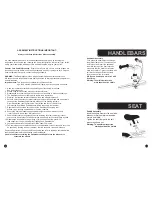
Safety
cont’d
16
Vehicles slowing or turning, entering the road or your lane ahead of you, or
coming up behind you.
Parked car doors opening.
Pedestrians stepping out.
Children or pets playing near the road.
Potholes, sewer grating, railroad tracks, expansion joints, road or sidewalk
construction, debris and other obstructions that could cause you to swerve into
traffic, catch your wheel or cause you to have an accident.
The many other hazards and distractions which can occur on a bicycle ride.
Ride in designated bike lanes, on designated bike paths or as close to the edge of the
road as possible, in the direction of traffic flow or as directed by local governing laws.
Stop at stop signs and traffic lights; slow down and look both ways at street
intersections. Remember that a bicycle always loses in a collision with a motor
vehicle, so be prepared to yield even if you have the right of way.
Use approved hand signals for turning and stopping.
Never ride with headphones. They mask traffic sounds and emergency vehicle sirens,
distract you from concentrating on what's going on around you, and their wires can
tangle in the moving parts of the bike, causing you to lose control and fall.
Never carry a passenger, unless it is a small child wearing an approved helmet and
secured in a correctly mounted child carrier or a child-carrying trailer
Never carry anything which obstructs your vision or your complete control of the
bicycle, or which could become entangled in the moving parts of the bicycle.
Never hitch a ride by holding on to another vehicle.
Don’t do stunts, wheelies or jumps. If you intend to do stunts, wheelies, jumps or go
racing with your bike despite KETTLER’s advice not to, read the Extreme, Stunt or
Competition Riding section of this manual, now. Think carefully about your skills
before deciding to take the large risks that go with this kind of riding.
Don’t weave through traffic or make any moves that may surprise people with whom
you are sharing the road.
Observe and yield the right of way.
Never ride your bicycle while under the influence of alcohol or drugs.
If possible, avoid riding in bad weather, when visibility is obscured, at dawn, dusk or in
the dark, or when extremely tired. Each of these conditions increases the risk of
accident.
C. Off-Road Safety
We recommend that children not ride on rough terrain unless they are accompanied by an
adult.
The variable conditions and hazards of off-road riding require close attention and
specific skills. Start slowly on easier terrain and build up your skills. If your bike has
suspension, the increased speed you may develop also increases your risk of losing
control and falling. Get to know how to handle your bike safely before trying to
increased speed or more difficult terrain.
Wear safety gear appropriate to the kind of riding you plan to do.
Don’t ride alone in remote areas. Even when riding with others, make sure that
someone knows where you're going and when you expect to be back
Always take along some kind of identification, so that people know who you are in
case of an accident; take along some food, a cool drink or an emergency phone call.
Содержание KC720-220
Страница 54: ...Notes 54...
















































